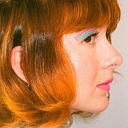Member-only story
Constructing Feminine Intimacies
Colette’s Living Environment (1972–1983)
“she thinks, the material and the dream can join,” — ‘Dreamwood,’ Adrienne Rich, Poetry Magazine, 1987
In 1972, after seeing an old parachute as someone’s apartment decor, Colette Lumiere (then known only as Colette) began stapling found fabric to the ceilings, walls, and floors of her Pearl Street loft. A decade later, her home would become an immersive installation known simply as the Living Environment, a fantastical interior that resembled more of a theater set than a typical domestic space with ruched drapery, ornamental lighting, and mixed-media sculptures as altered furniture. Up until the work’s conclusion in 1983, Colette continually added to the space while she lived here, turning it into an active site of staged performances and photographs wherein the Living Environment was both the artwork itself and the backdrop for other artworks, immersing the viewer and resident in a sensory experience of dreamy soft forms.
Before the Living Environment took over her apartment, Colette began her career on the streets of SoHo, creating public artworks where she’d pose as famous mythological and historical heroines in storefronts. Troubling the boundaries between private and public, fantasy and reality, Colette incorporated sleep into her live performances by napping…
